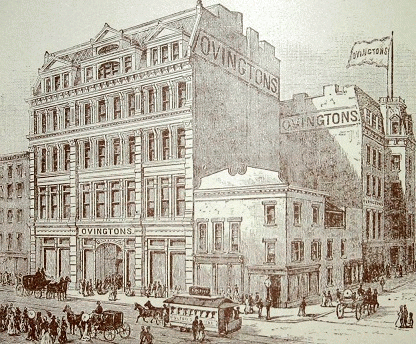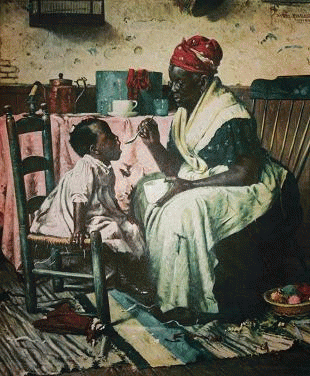The coming of Spring is unequaled in its power to spark fresh ideas in creative minds. Melting snow, thawing brooks, budding flowers and a warm breeze or two after a long and hard winter inevitably open the spirit to possibilities never before thought of. So it must have been for the young portraitist as he anticipated a bright future among his new-found friends. Commissions, exhibitions, and a studio, surrounded by artists of like mind, in a congenial neighborhood less stress-filled than Manhattan--the pluses all crowded his mind, while not entirely putting to rest the apparent negatives such as reduced exposure to the clamoring front line of the established art world. But even considering the downsides, a move to Brooklyn looked like a step in the right direction. And the possibility of romance lurked in the undercurrent of his thoughts. Whatever it was, Stanis gradually appeared to be coming under the spell this graceful abode on the other side of the East River.
In terms of the arts, Brooklyn was not as much of a backwater as one might at first imagine. As far back as 1824, Brooklyn civic leaders felt the time was ripe to guide the artistic and cultural development of the city. They established a library that evolved into the Brooklyn Institute, later to become the full-blown Brooklyn Institute of Arts and Sciences. This last umbrella organization offered courses and presentations in a broad range of subjects. Through the decades, it added to its roster of departments, until by the late 1800s it became akin to a university in its own right. It spun off, as independent institutions that still exist today, the Biological Laboratory at Cold Spring Harbor, the Brooklyn Museum of Art, and the Brooklyn Children's Museum.
The press was not unconscious of the strong cultural currents that were taking up so much of the time of Brooklyn folks. It fueled the flames of artistic development by providing detailed coverage of the arts that included frequent visits to artists' studios and reports on the progress particular artists were making. These developments all occurred in tandem with an economic boom in the late 19th Century, driven by the flurry of technical innovations such as the telegraph, telephone, steamboat, and engineering breakthroughs that made possible the construction of massive projects like the Brooklyn Bridge and a forest of skyscrapers in lower Manhattan. Brooklyn, however, was not about to be outdone by Manhattan or even Washington, D.C. It would have its major art museum, its performance space, and its libraries. These were all constructed, maintained, and liberally used. It was upon this foundation that a community of up-and-coming painters and sculptors took root, blossomed and flourished. But the need for studio space for artists often presented a challenge, as the commercial boom put a priority on available rentals for business purposes. When major businesses expanded, however, they would vacate older buildings for the new, and studio space began to open up. Among the most prominent examples of this trend in Brooklyn was the Ovington Building on Fulton Street.
The Ovington brothers had run a brisk trade in ceramics, pottery, table ware and sculpture since the mid-1800s. In the 1870s, they opened a fine two-story building encompassing several storefronts along Fulton Street at the edge of the downtown shopping district. Their stock included some of the finest examples of china and porcelain one could obtain, much of it imported. A table setting, for example, might sell for as much as $3,000, or the equivalent of $195,000 today.

Ovington Brothers Building, from an 1887 Ovington Brothers catalog.
(Image by Peter Duveen) Details DMCA
One cold winter morning in 1883, however, a fire broke out in the lower stories of the store just before opening time. Two employees rushed out to the street to escape the flames, only one of them belatedly pulling an alarm to alert local firefighters. Engines arrived some 30 minutes after the initial outbreak of the fire, which quickly spread to the upper floors, engulfing the entire building and threatening a church and neighboring structures. These buildings were saved when the fire was finally brought under control, but both the stock and structure of the Ovington Brothers store was a total ruin.
Losses were estimated as upwards of $250,000, or $16 million in today's dollars. Amazingly undaunted by the loss, the company was determined to rebuild. It set up headquarters in a nearby church, and by November of 1883, a mere 11 months after the disastrous fire, a new six-story department store, equipped with modern elevators, opened to much fanfare and excitement. The firm prospered in its new location, and soon opened a branch in Manhattan. Eight years would pass before it abandoned its Fulton Street store for more attractive retail space on nearby Flatbush Avenue in the middle of the downtown Brooklyn shopping district. That fateful decision was to have the side effect of providing a haven for a robust community of painters and sculptors that would eventually fill the building Ovington Brothers had vacated, although the firm would still retain ownership for years to come.
It might be of interested to the reader to know that the land upon which the Ovington Building stood, was owned by none other than Martha Middagh, heir to a large swath of what was once farmland in the heart of Brooklyn Heights. Upon her death, the landed estate was distributed among three surviving daughters, among whom was Sarah Middagh Gracie. When the latter died around 1900, her share passed to her adopted daughter, Cornelia Middagh Gracie Henshaw, the matriarch of the Henshaw clan that plays so prominently in this narrative. The parcel leased by Ovington Brothers was finally acquired by the firm around 1909, but the legal back and forth between the Henshaws and the Ovingtons left a somewhat unpleasant aftertaste in the affairs of the two families. Corrie, who was Cornelia's daughter, blamed a less than scrupulous attorney for the disadvantageous transaction that relieved the Henshaws of ownership of the parcel. But back to the story.
Among the first tenants of the vacated and rather immense six story structure was an arm of the aforementioned Brooklyn Institute, the Brooklyn Art School, which brought with it an appreciable roster of students and faculty around 1890. Soon following suit were a bevy of painters and sculptors who opened individual studios in the building, many of whom would keep them for most of their artistic careers.
Benjamin Osro Eggleston, an import from the Midwest who, like many artists of the time, cut his artistic teeth as a newspaper illustrator, was one of the first to occupy the building. After only a few years in Brooklyn, Eggleston's pictures, which ultimately were executed with a crisp, insightful style as his work matured, had attracted attention and notice in local papers, and were included in the annual exhibitions of the National Academy of Design. Harry Roseland, known for his heartfelt renderings of African-American life, also opened a studio there, and the men were seen as friendly competitors by the press. Harry Roseland would keep a studio in the building until his death in 1950. Two women artists of some prominence, Edith Sawyer and Eleanor Bannister, also took studios in the building, which before long was abuzz with colleagues running to and fro in the hallways, and up and down the elevators. On the main floor was a produce shop that would draw its own clientele, while providing tenants with shopping convenience. In 1924 when Stanis arrived on the scene, the building was bustling with activity.
In the meantime, the 20th Century brought to the Brooklyn arts community its own set of innovations. At the beginning of the century, the latest experimental trends in Europe were but rumblings in America. The public had not yet been introduced to the radical schools of abstract art that were emerging in Germany and France. The National Academy of Design, established in the 1820s by artists that included portraitist and inventor Samuel F.B. Morse, maintained such a tight control over the local art scene in the early 1900s that it sparked a rebellion among the many artists who were refused admission to its shows. In the first decade of the century, Robert Henri, known for his warm impressionist portraits, organized a group that would buck the Academy's control over American art. Their first show in 1908 sent shock waves through the art world. The band of upstarts--Henri, John Sloan, William Glackens, Maurice and Charles Prentergast, among others--were cast by the day's mainstream media as "Ashcan" artists, whose choice of themes -- often realistic streetscapes instead of idealized pastures--were considered below the standards of acceptable work. But the works of these artists "The Eight" they were called--eventually caught the eye of the public and art patrons.
A few years later, many of these same artists, along with some associated art critics, organized a show that highlighted new and controversial works in abstract and expressionist styles that the Atlantic Ocean had heretofore protected the American public from. The Armory Show of 1913, as it is now referred to because it was held in an armory in New York City, shook the American art world to its foundations, and set the tone for most of the 20th Century. These upheavals paved the way for other arts groups in America that would promote exhibitions by their members without having to go through a single academy or other elitist organization.
As the second decade of the century rolled to a close, a new organization in Brooklyn emerged to support the borough's artists. Known as the Brooklyn Society of Artists, this group met formally each month, and launched a series of annual exhibitions--the first in 1917--to expose the public to its members' work. Many artists in the Ovington building joined and became officers of the BSA, which would eventually emerge as a national organization, the Society of Contemporary Artists. A conflict between the members over whether the group should promote new trends in art as opposed to what appeared to be the more staid and less experimental styles among them led to the formation of two splinter groups, the Brooklyn Society of Modern Artists and the Brooklyn Painters and Sculptors, the former considering itself the cutting edge while the later preserving the time-tested techniques of classical art. Watercolorists, etchers and miniaturists had their separate clubs. It is quite evident that, with the proliferation of these competing groups, Stanis would not arrive in Brooklyn to greet a void in culture. In terms of his profession, at least, he would not be on foreign soil, although his predilection for realism and love for the Old Masters put him and many of his colleagues at odds with the emerging trend that was to be called modern art. For Stanis, this was a fight that would endure through his dying days.





